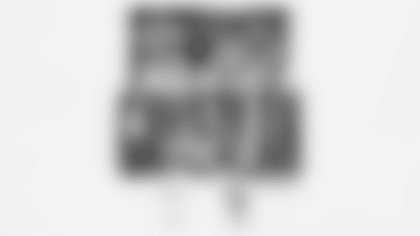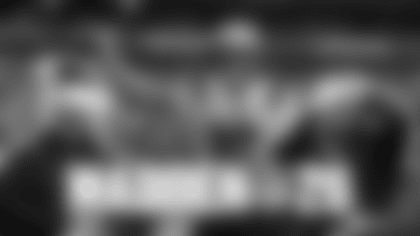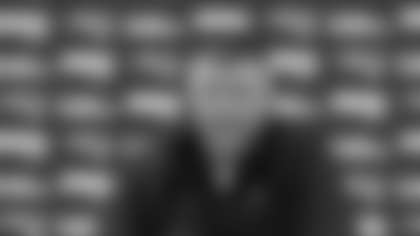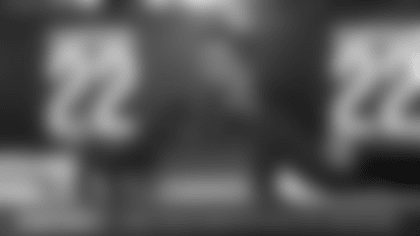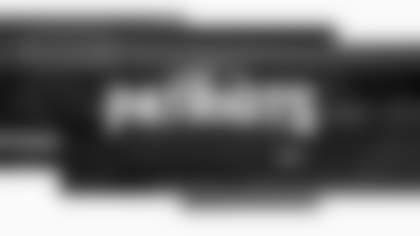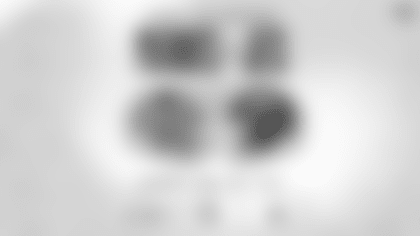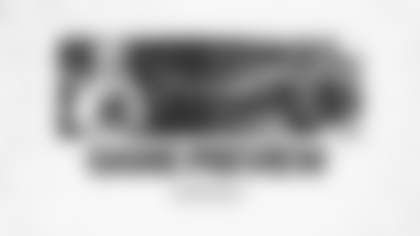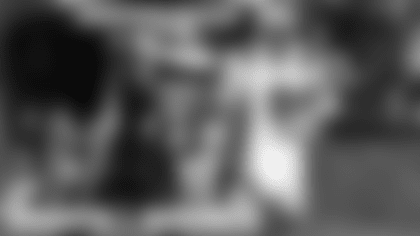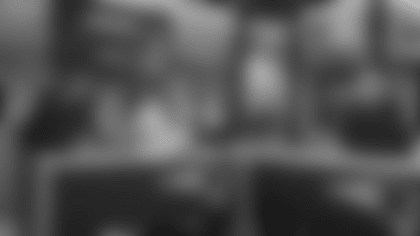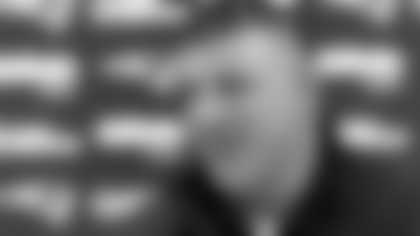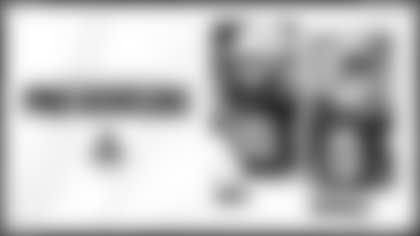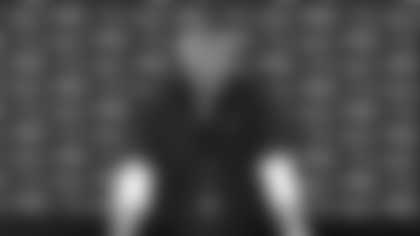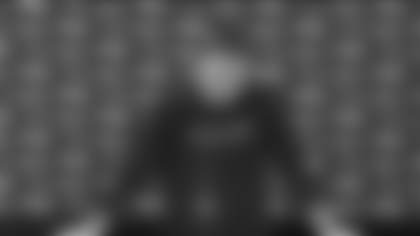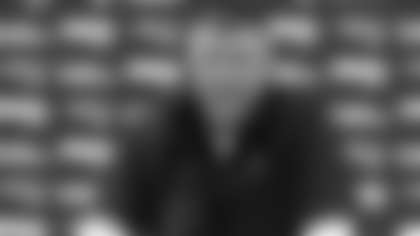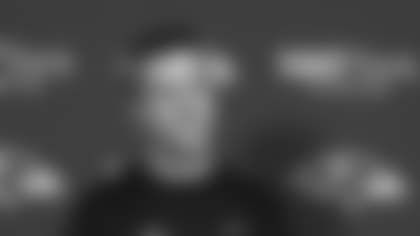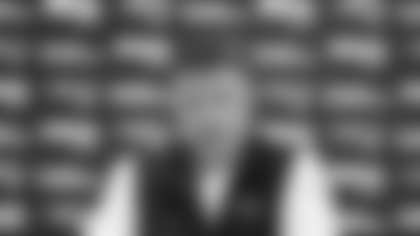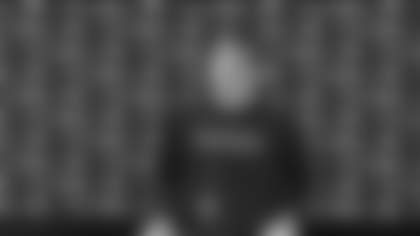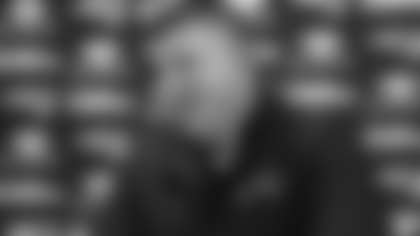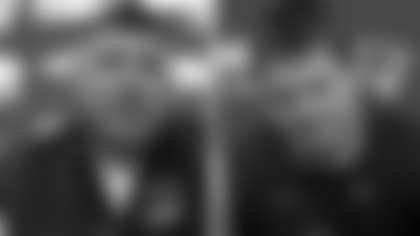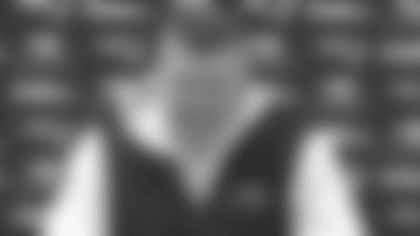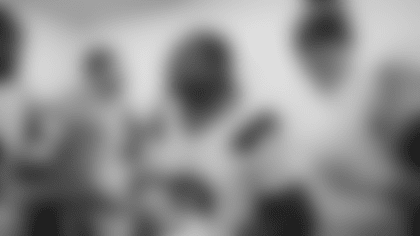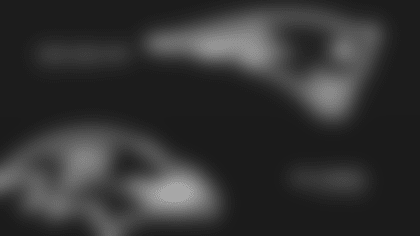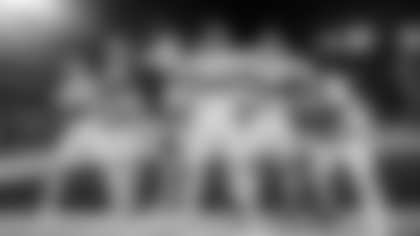[wysifield-embeddedaudio|eid="503511"|type="embeddedaudio"|view_mode="full"]
Q: What did you see on LeGarrette Blount's touchdown run now that you've had a chance to go back and watch it on film? It looks like James Develin and Martellus Bennett had a nice double-team block going on.
BB: Yeah, I'd say that's the way it looked in the game. I thought he could've gone inside and probably gotten the first-down, but he saw some space outside and I think made the right decision. Really similar to the other fourth-down play. There was a little bit of space inside, too, on that one. He took that one outside for about a five-yard gain.
Q: Does his vision and ability to think quickly at the last moment get overlooked as a part of LeGarrette Blount's game?
BB: Well yeah, I think any good back can do that. They see things that they see from their perspective and they have to gauge the hole, their speed, the defenders speed or body position, how quickly they can get to where he wants to go and how much time they have to set it up and so forth. A lot of that position is instinct. I mean look, backs miss reads like everybody else misses plays. A lot of plays are hard to second guess what they see and what they reacted to because they want to gain yards just like everybody else does.
Q: What do you like about the two-back formation with James White and Dion Lewis and does that formation pose any risks seeing how they give up some size there in the backfield?
BB: Well, I think it's like anything else we do. Whatever formations and groupings we run and plays we run, we try to gain an advantage and where we think we can gain advantage we try to take advantage of it, and where we don't we try to avoid that situation. I'm sure it'll change from game to game depending on how defenses will play that or how we think they'll play it and what we want to try and do and so forth. But we'll just have to see how it goes. We have a lot of variations like that. Sometimes we use them, sometimes we don't. Sometimes it shows up more in one game than another. Those are game plan decisions. We'll just have to see how it goes.
Q: When breaking down film with the team do you view the opposing offense dropping balls as their ineffectiveness or do you get on your guys to show them that it could've been a breakdown on your defense that just wasn't taken advantage of by the opponent?
BB: Well, we try to coach and correct every play; good plays and plays that aren't so good regardless of what happened. Sometimes the offense misses an assignment or they make a mistake or whatever the case might be. We want to be aggressive and take advantage of it but at the same time we can't always count on those things happening, so we have to make sure we play our responsibilities properly so if that doesn't happen we're not out of position. So we try to coach and correct every play.
Q: It looked like at times Kyle Van Noy was the communicator out there on defense. What have you seen from him that has allowed him that responsibility despite the short time he has spent here?
BB: Well, just like the quarterback position on offense, even if you bring in somebody that doesn't have a lot of experience they still have to call the plays, so that's part of the positon, part of the job. Kyle [Van Noy] has worked hard. I think he's gaining a better understanding and grasp and communication on the defense every day, every week. There's still certainly a ways to go but he's made a lot of progress and we have confidence in him doing that.
Q: Was there any thought to taking Tom Brady out of the game late once it seemed the victory was in hand or is it more of a mentality that you wouldn't want to let up from start to finish?
BB: Well, after the game turns out it's easy to go back and make those comments, make those suggestions. But I've seen a few games in this league, seen those double-digit leads evaporate in a minute or two. I know that's not a big concern when it doesn't happen but then when it does happen it's a major crisis and then there's a lot of second guessing about what should've been done or shouldn't have been done. We just try to keep moving in the game. We're just trying to win the game.
Q: What did you see from Jabaal Sheard on the film both in dropping into coverage and rushing the passer?
BB: Well, we know he can rush the passer. The coverage plays were pretty impressive. It could be a season for a defensive lineman with the number of balls he had his hands on. Yeah, very impressive awareness and getting depth to get into the passing lanes, playing the ball. It was great. When you drop defensive linemen into coverage you generally don't get a lot of production from them in coverage. They take up some space and kind of I'd say usually the quarterback doesn't want to throw the ball in the area where somebody's standing there but in terms of making plays on the ball they don't generally make a lot of them. So that was a great job by Jabaal [Sheard] yesterday. He rushed well, he played the run well. He's had a couple of good weeks here so it's good to see him string them together.
Q: On Kyle Van Noy's interception did you see Vincent Valentine's pressure on Jared Goff at all affect his ability to step up in the pocket and avoid pressure from Jabaal Sheard?
BB: I think [Vincent] Valentine had a good power rush there. He got into the pocket five or six yards maybe, but it was a relatively clean lane for [Jared] Goff to step in. It looked like [Jabaal] Sheard either hit his hand or hit the ball just as he was releasing it and that really made the play. But Vincent had good pressure. He was able to, had Goff stepped up in the pocket, I think when Vincent kind of spun back he probably would've hit Goff if he'd moved up. But he didn't really get a chance to move up because he delivered the ball and Jabaal hit him. Anytime you can hit that ball and affect it, I mean we were fortunate on one we had where it was a similar type of play. It was tipped up there and James White ended up catching it but those are always very dangerous plays offensively when the ball gets tipped or batted or the quarterbacks arm gets hit and the ball is in the air in the middle of the field for a little bit longer time or a little bit out of location where he's trying to put it. So this was one that kind of fortunately fell to us. The other one was fortunately - James made a good play on the ball to go up and get it and probably would've broken up a potential interception anyway. Those plays usually aren't good for the offense. It's part of ball security and being able to throw in a clean pocket, whether it's the quarterback getting hit or the ball getting tipped or the quarterback throwing the ball around the defender so it doesn't get tipped. The combination of all of those things, getting a clean throwing lane and a clean throw, when you don't have one offensively it's usually, like I said, not a good thing.
Q: On that interception Kyle Van Noy seemed to come up on the play-fake then recover to drop back in coverage. Is that ability something you've seen him display often over his time here this season?
BB: Yeah, I mean Kyle [Van Noy] is a pretty athletic player. He runs well. I don't think there's any question about that. The play was a play that they had run earlier in the game in the first quarter and I think they were trying to throw the over-route to [Brian] Quick and when [Jared] Goff's arm got hit the ball went like maybe 10 yards behind the receiver. So he was trying to throw it out I would say around the numbers and the ball ended up somewhere between the hash marks in that area, so it ended up being offline by quite a bit. But they were trying to hit the over-route off of the play-action. Again, a play they had run earlier in the game and Kyle made a nice adjustment to the ball once it was in the air to, as you mentioned, to be able to slide and jump off-balance and make a clean catch. It was a good play on the ball. He wasn't really the one covering the pattern. I think that was Malcolm [Butler] chasing the over-route and Shea McClellin was dropping back into that underneath zone so the ball would've had to go over McClellin and to Quick away from Malcolm Butler. There was a little bit of space there. He had a chance to get it in there.
Q: When evaluating a blitz from a defensive back do you judge its success as to whether or not he gets the quarterback on the ground or can it be just as effective to rush him out of the pocket or hurry the throw?
BB: Well, sure. Anything that affects the passing game can be a good thing. As you said, getting pressure, flushing him out. A lot of times, again, it depends on what the rest of the play is and how many people are coming and what the coverage is and so forth. A lot of times when you bring a player from the perimeter it forces one of the eligible receivers, usually the back but it could be a tight end, to stay in and protect and so that is one less receiver you have to cover, which could either free somebody up or the man who's covering could come as a second blitzer so you actually add in to the rush. In a similar fashion, anytime you bring five players, like the Rams did on numerous occasions in the game, I mean all teams do it. We do it. When you bring five rushers and it doesn't keep one of the eligible receivers in, so just five-on-five with the offensive line, then you get all singles on the pass rush. So that creates some opportunities, too. Again, it kind of depends on what you're trying to do. Of course if nobody picks him up that's great. That doesn't always happen but a lot of times you plan those type of plays thinking that if you don't come free you'll force one of the receivers, [Benny] Cunningham or [Lance] Kendricks, to stay in and protect and then that's one less guy you have to cover. There's a lot of different strategies to doing that relative to what's going on in the inside part of the defense, whether you're playing man or zone behind it, kind of which side of the formation you're coming off of, whether it's the passing strength, or to the tight end, or to the back, or away from the back, or away from the tight end or so forth. Pass protections change some matchups and if you can get a favorable one then that's maybe something you want to consider. If it leads too big of a void or creates a problem for you then it's something you don't want to do or maybe you don't want to bring the player off of a certain side or off of a certain receiver because of the way they adjust to it.


